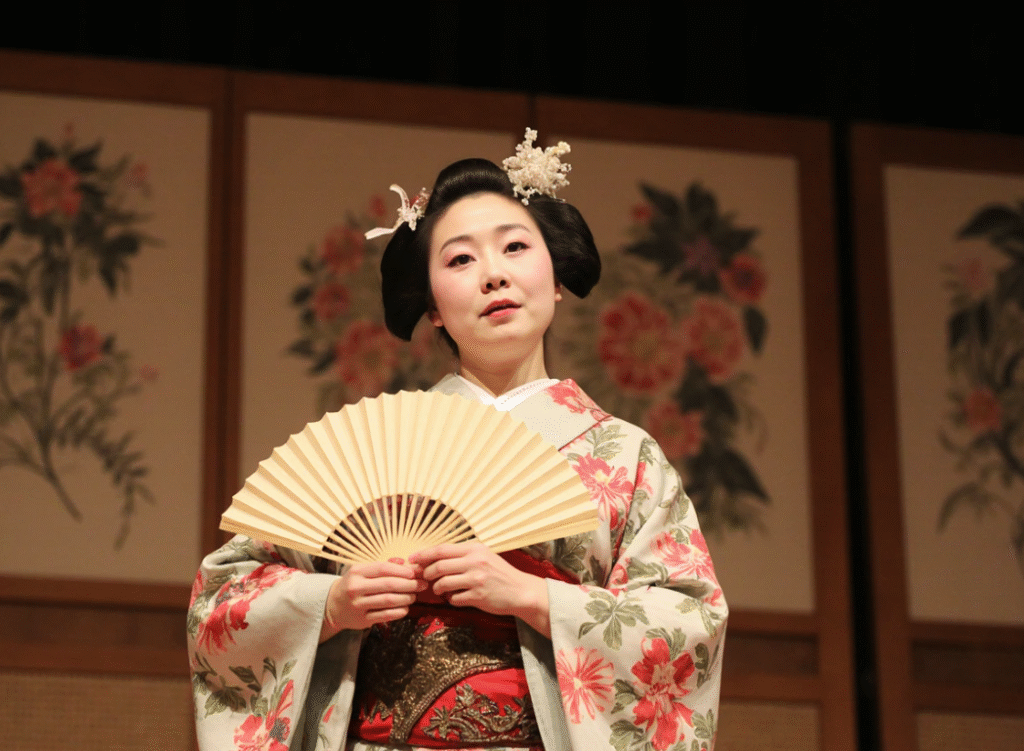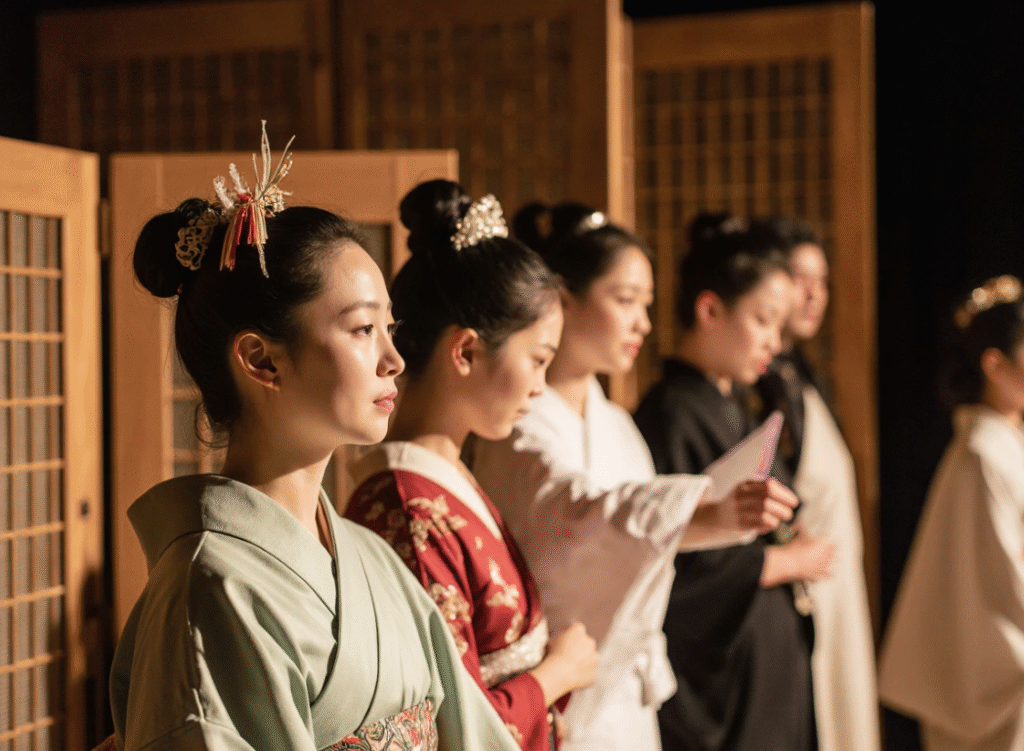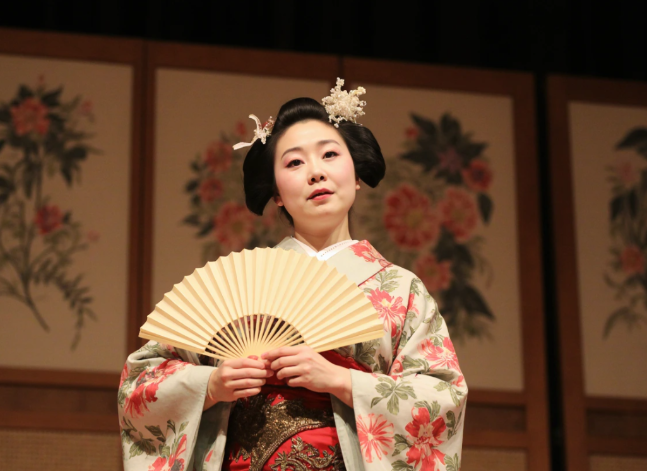You’re planning a Kyoto trip for spring. You’ve seen photos of geisha in flowing kimonos, but where can you actually watch them perform? The Kamogawa Odori, held May 1-24 annually at the Pontocho Kaburenjo Theatre, offers the most accessible way to experience authentic geiko and maiko culture in Kyoto’s historic entertainment quarter.
This isn’t another tourist show. Dating back to 1872, Kamogawa Odori boasts the most performances among Kyoto’s five hanamachi districts. You’re watching a tradition that survived wars, modernization, and 150+ years of change.
More about Pontocho:
- Pontocho Park Guided Tours
- The Complete Guide to Pontocho: Kyoto’s Most Atmospheric Alley
- Geisha and Maiko in Pontocho: Tradition, Etiquette, and Okiya
What Actually Happens During the Performance?
The Pontocho spring dance is divided into two parts: dance drama first, then traditional dance called “odori emaki”. Duration runs 60-70 minutes without intermission.
Part One tells seasonal stories rooted in Kyoto culture. Think of it like watching narrative ballet. Part Two strips away the story to showcase pure technique — every gesture must be perfect.

Kamigawa Odori Dance Performance – Book Tickets for Kamogawa Odori Dates.
Geiko from Pontocho are famous for fan choreography. Watch how they manipulate fans to suggest falling cherry blossoms, flowing water, or shifting seasons. This signature style separates Pontocho from Gion Kobu and other districts.
Here’s how Kamogawa Odori compares to other spring dances:
| Feature | Kamogawa Odori | Miyako Odori | Kitano Odori |
| When | May 1-24 | April 1-30 | March 20-April 2 |
| District | Pontocho | Gion Kobu | Kamishichiken |
| Signature | Fan choreography | Cherry blossom themes | Intimate performances |
| Price | ¥6,000-7,000 | ¥4,000-7,000 | ¥6,000-7,000 |
The May timing matters for Kamogawa Odori. This is the only spring geisha dance held in temperate May. April brings peak cherry blossom crowds. By May, tourism pressure drops while the weather stays excellent.
Photography and video are strictly prohibited during the Pontocho performance. Put your phone away before the curtains rise.
How to Get Kamogawa Odori Tickets
Critical information most guides miss: You cannot buy regular seats (¥4,000) online for Kamogawa Odori. Only Special Seats are available for web purchase.
Your Kamogawa Odori ticket options:
- Special Seats with Tea: ¥7,000 ($47)
- Special Seats: ¥6,000 ($40)
Regular seats must be purchased through travel agents like JTB or View Plaza. For international tourists without Japanese travel agent access, you’re effectively choosing between two options, not three.
What’s the difference?
Special Seats with Tea (¥7,000):
- Better viewing angle on third floor at Pontocho Kaburenjo
- Maiko greeting from 11:10-11:40 AM before first daily performance only
- Pre-show tea ceremony experience
- Tea served at tables and chairs — a method created in 1872 for foreign guests
Special Seats (¥6,000):
- Same third-floor seating
- No tea ceremony
- No maiko greeting
The ¥1,000 ($7) difference buys interaction with Pontocho performers before they transform into stage artists. This isn’t a full private tea ceremony (those cost $200-500). It’s a shortened version providing brief cultural immersion.
Booking Process for Kamogawa Odori Tickets
Purchase Kamogawa Odori tickets through the official website at https://en.kamogawa-odori.com/. Book 2-3 weeks ahead for weekends.
After payment, you’ll receive a PDF voucher by email. You MUST either print this voucher or have it ready on your smartphone/tablet. At Pontocho Kaburenjo Theatre, exchange the voucher for your actual entrance ticket at the box office.
If you arrive without the voucher, you cannot enter the performance. Period.
Questions about Kamogawa Odori tickets? Call 075-221-2025 (weekdays 10:00 AM-5:00 PM, weekends during performance season).
Kamogawa Odori Dates and Performance Schedule

Discover Kamogawa Odori Theater – How to See Kamogawa Odori in Kyoto.
Kamogawa Odori performances run May 1-24, 2025 at 12:00 PM, 2:00 PM, and 4:00 PM. Three daily shows at Pontocho Kaburenjo provide scheduling flexibility for your Kyoto itinerary.
Venue: Pontocho Kaburenjo, Nakagyo-ku, Pontocho, Sanjo Sagaru, Kyoto.
From Kyoto Station to Pontocho:
Take Karasuma Line to Oike Station, transfer to Tozai Line, exit at Kyoto Shiyakusho-mae Station. Take Exit 6 for a 5-minute walk to Pontocho. Total time: 20 minutes. Cost: ¥260 ($1.75).
Alternative: Keihan Railway to Sanjo Station, Exit 6, then 5-minute walk to the Pontocho district.
Taxi costs ¥1,000-1,200 ($7-8) but subway wins during rush hour when traveling to Pontocho.
Don’t drive to Kamogawa Odori. No parking exists at the venue. Pontocho is a narrow pedestrian alley where cars cannot enter.
“Arrive 45 minutes before your Kamogawa Odori performance time. You must exchange vouchers for tickets at the Pontocho Kaburenjo office. Lines form on busy days. If you bought tea ceremony access for the noon show, the maiko greeting runs 11:10-11:40 AM. Arriving at 11:45 means missing what you paid extra for.”
The Three Mistakes That Ruin This Experience

Discover Kamogawa Odori Theater – How to See Kamogawa Odori in Kyoto.
Assuming You Can Buy Regular Seats Online
You read ¥4,000 Kamogawa Odori tickets and plan accordingly. You arrive at the booking website. Those tickets aren’t there.
Why tourists make this mistake: Most English-language guides list all three ticket tiers for Pontocho performances. But the official website only sells Special Seats. Regular seats require Japanese travel agent access.
Price of this mistake: You either pay ¥2,000 ($13) more than planned or scramble to find JTB offices in Kyoto (which require time and Japanese language skills). Or you don’t attend Kamogawa Odori at all.
Solution: Budget for ¥6,000-7,000 tickets from the start. If you must have ¥4,000 seats, arrange a purchase through a Japanese-speaking friend or hotel concierge before your trip.
Booking Standard Seats for Your Only Geisha Experience
You’re spending ¥6,000 anyway (since regular seats aren’t online-available). You skip the ¥1,000 tea ceremony upgrade to save money.
Kyoto is expensive. Saving ¥1,000 per person makes sense. But here’s what happens at Kamogawa Odori:
You skip the pre-show tea ceremony. You skip the maiko greeting. You go straight to your seat. The performance starts. It’s beautiful. But you never interacted with the Pontocho artists. You watched from a distance.
Price of this mistake: You traveled 6,000 miles. You allocated 90 minutes to something unavailable at home. You saved $7 but missed the humanizing interaction that transforms performers from distant figures into real people practicing an ancient craft.
For couples attending Kamogawa Odori, that’s $14 saved on a $2,000+ trip. That’s 0.7% of trip budget. Meanwhile, the tea ceremony moment creates the lasting memory you’ll describe to friends.
Solution: If this is your only geisha performance, buy Special Seats with Tea. That extra ¥1,000 purchases cultural immersion, not just better seats.
Showing Up at Showtime
The Kamogawa Odori performance starts at 12:00 PM. You arrive at 11:55 AM thinking you’re on time.
You must exchange your voucher for an entrance ticket before the show. That exchange happens at the Pontocho Kaburenjo box office. On busy days, lines form. If you arrive at 11:55, you’re either late or stressed.
Worse: If you bought tea ceremony tickets, that experience runs 11:10-11:40 AM. Arriving at 11:55 means you completely miss what you paid for.
Price of this mistake: For tea ticket holders: ¥1,000 wasted, plus the stress of rushing. You start the performance anxious instead of centered. That anxiety colors your entire Kamogawa Odori experience.
Solution: Arrive 45 minutes before showtime at Pontocho. Exchange tickets leisurely. Enjoy the tea ceremony if you bought it. Enter the theater calm and ready.
How to See Kamogawa Odori: Understanding Pontocho District
The Pontocho district didn’t always exist. What’s now Pontocho was Kamo River until 1670, when levee construction created new land. Merchants needed rest stops along the river. Entertainment businesses followed.
First ochaya tea houses opened in Pontocho in 1712. One century later, the street received official hanamachi status.
The Kamogawa Odori spring dance tradition began in 1872 for Kyoto’s first World Fair. Tokyo had become Japan’s new capital in 1868. Kyoto needed tourism to survive economically. The city bet on tradition as attraction.

Behind the Scenes of Kamogawa Odori – Kamogawa Odori Tickets and Dates.
That decision saved the Pontocho district. The area could have modernized like other neighborhoods. Instead, it doubled down on geisha culture. The Pontocho Kaburenjo Theatre opened in 1927 — the same venue where Kamogawa Odori performances happen today.
The entertainment district stretches just 500 meters but packs restaurants, bars, and tea houses into that narrow alley. Look for the chidori (water plover) crest on lanterns throughout Pontocho.
What You’re Actually Watching at Kamogawa Odori
Performers wear kimonos costing $10,000-50,000. You’re watching artists who spent years learning to walk correctly in these garments before they danced in them. Maiko apprenticeship in Pontocho runs 5-7 years minimum.
All performers are women — dancers, shamisen players, drummers, vocalists. The musicians sit stage left during Kamogawa Odori. Watch them. They’re as skilled as dancers.
The Pontocho performance uses highly stylized movement. Every gesture connects to Japan’s seasonal aesthetics. A hand movement suggests spring rain. A fan position indicates early autumn. Many performances typically celebrate “shinryoku” — the fresh greenery after cherry blossoms fall.
Understanding ma (negative space): When dancers pause during Kamogawa Odori, when music stops, when the stage sits silent — those aren’t transitions. They’re intentional artistic statements. Silence is art.
The entire show uses Japanese with no subtitles. You’ll miss narrative nuances. Some find this meditative. Others find it boring after 20 minutes.
Honest Assessment: When Kamogawa Odori Disappoints

Not every traveler leaves Pontocho fulfilled. You should know these scenarios:
- You want entertainment: Kamogawa Odori is formalized art, not a tourist show. Expect slow, precise, repetitive movements. If you’re expecting Broadway energy, you’ll be disappointed.
- You can’t sit still for 70 minutes: No intermission during Kamogawa Odori. No translation. If you fidget through movies, you’ll struggle here.
- The budget is genuinely tight: ¥6,000-7,000 ($40-47) per person means $80-94 for couples. If you’re backpacking on $40/day, this represents 2+ days of budget. Other Kyoto experiences like Fushimi Inari Shrine cost nothing.
- You’re traveling with young children: Kamogawa Odori requires silence and stillness. A child who can’t sit through a movie won’t sit through this.
Better alternatives for these travelers:
- Free geiko spotting in Gion Higashiyama around 6:00 PM
- Gion Corner’s 50-minute cultural show ($24, includes English explanation)
- Walking the Pontocho entertainment quarter at night to see the district without performance costs
“First-timers ask: Miyako Odori or Kamogawa Odori? Miyako Odori is more famous. But Kamogawa Odori in Pontocho offers better value and lighter crowds. April means peak cherry blossom tourism — hotels cost 40% more, restaurants need reservations, sites overflow. By May, that wave has crashed. Hotel rates drop. You’ll experience Kyoto without fighting crowds. If you’re not locked into April dates, choose Kamogawa Odori for experience quality over name recognition.”
Beyond Kamogawa Odori: Completing Your Pontocho Visit
After the show: Walk the Pontocho district’s 500-meter length. See the lanterns with chidori plovers. Pass the ochaya where tonight’s private performances happen. From May-September, Pontocho restaurants build kawayuka platforms over the Kamo River for open-air dining.
This 20-minute walk transforms abstract art into lived reality. The Kamogawa Odori dance referenced these Pontocho locations. The music evoked the river flowing 50 meters away.
Nearby experiences within 15 minutes of Pontocho:
- Yasaka Shrine: Gion Festival origins, 12-minute walk, free entry
- Nishiki Market: “Kyoto’s Kitchen,” 7-minute walk, free browsing
- Kennin-ji Temple: Kyoto’s oldest Zen temple, 7-minute walk, ¥600 ($4) entry
Lunch strategy: Restaurants along the narrow Pontocho alley range from ¥1,200 yakitori stands to ¥30,000 kaiseki. Mid-range options (¥3,500-7,000 per person) offer quality without reservations. Arrive 1:00-2:00 PM to avoid peak crowds.
Final Preparation Checklist for Kamogawa Odori
Bring to Pontocho Kaburenjo:
- Printed voucher or phone with PDF ready
- Cash (many Pontocho shops don’t accept cards)
- Light jacket (theater air conditioning runs cold)
Wear to Kamogawa Odori: Business casual minimum. Shorts and tank tops look disrespectful at traditional performances.
Don’t do during Kamogawa Odori:
- Arrive late (doors close at start time)
- Use phone during show (immediate ejection)
- Eat/drink in theater
- Talk during performance
Address in Japanese for taxi drivers to Pontocho: 京都市中京区先斗町三条下る
One Last Reality About Kamogawa Odori
You’ll spend 90 minutes watching an art form you won’t fully understand. You’ll miss cultural references. You’ll lose the narrative thread.
And it might still be your most memorable Kyoto experience.
Because you’ll witness something existing nowhere else. No other country maintains a 150-year tradition of professional female dancers performing seasonal choreography in hand-made silk to live shamisen in century-old theaters. You can watch ballet in New York, flamenco in Spain, kabuki in Tokyo. You can only watch Pontocho geiko perform Kamogawa Odori in this 500-meter alley during 24 days every May.
The art survives not because it’s easy or commercially optimized. It survives because it refuses to change. The Kamogawa Odori performance format hasn’t changed since 1872. What you’ll see at Pontocho is what audiences saw 150 years ago.
Whether that moves you or bores you depends on what you came to find.
